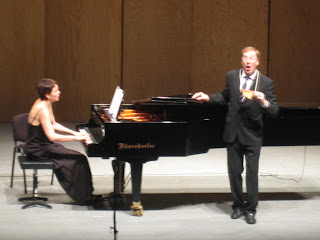Recital de Gilles Cachemaille y Esther Walker en Monterrey

La siguiente crónica sobre el reciente concierto de Gilles Cachemaille y Esther Walker es en inglés. No se trata de un acto de mamuquería de mi parte sino que el "review" lo realicé para un sitio angloparlante del que soy miembro. Prometo traducirla esta semana para aquellos que prefieren con justicia nuestra querida lengua castellana.
A PASSIONATE STYLISH NIGHT
On Tuesday night, August 14, Gilles Cachemaille - baritone and
Esther Walker - piano gave a recital as part of the Autumn Festival
of Nuevo León Radio. It was one of those magical nights where the
artistry of both musicians resulted in a music making of rare
expression and emotion.
This was the first presentation of Cachemaille in Mexico, so it was
an important event for us lovers of the lyric art. The program was an
exquisite one; the first part included selections of Beethoven's
Italian songs, melodies by Saint-Saens and the Don Quichotte songs by
Ravel.
Cachemaille has a commanding presence on the stage. His voice, a warm and
expressive instrument with a slight dark colour was used with the
utmost musicality. He's one of those singers that can make what they
please with their voice. His rendition of "In questa tomba oscura"
was a harrowing experience; desperate but dignified. He began to loosen up and by the Saint-Saens selections (the four of them
wonderful songs) he was creating a whole universe for each gem; "L'
attente" and "Aimons nous" had a depth of expression we don't often
find in this essentially classic composer.
Cachemaille has full command of the messavoce and contrasting
dynamics from piano to forte without losing the main focus of his
voice. He has a reasonably large sized voice of ample emission. "Danse Macabre"
was greeted with enthusiastic applause and he created a spooky world
using at "horreur" or "et vive la mort e l'egalite" a type of sprechgesang tastefully employed. The first part concluded with the enchanting Ravel settings and the chanson a boire was a high spirit bash and suitable conclusion for the first part.
Throughout the first part Esther Walker's accompaniment was careful
and with a stylish touch. She has a deep affection for the lied and
melodie repertory and it shows in her shaped phrases. She isn’t afraid of a big gesture when the music allows it. Interestingly she approached melodie with a German lied style a valid view. Her Mozart had flair and character but it can profit with more ductility. She's still a young and talented pianist.
The second part was devoted to Mozart. We listened a selection of
Cachemaille's favourite roles and showed his command both for serious
and comic roles: His Nardo aria was full of brilliant characterization and the use of different languages and postures; the French chevalier, the English phlegmatic the Italian passionate. The Giovanni serenata was almost like an atmospheric sigh but his "ai gia
vinta la causa" was a trenchant and violent rendition, darker toned and with a more concentrated projection. Figaro's anguish in "aprite un po" was tonally more rounded. But it's delightful to return to the funny side of Cachemaille with
his two final renditions of Leporello's madamina and Papagaeno "der
vogelfanger"(complete with flute). He has a command of colour and
characterization of both roles and suddenly I forgot we had Gilles Cachemaille in front of us.
A memorable night for Monterrey
Ricardo Marcos G.

Comentarios